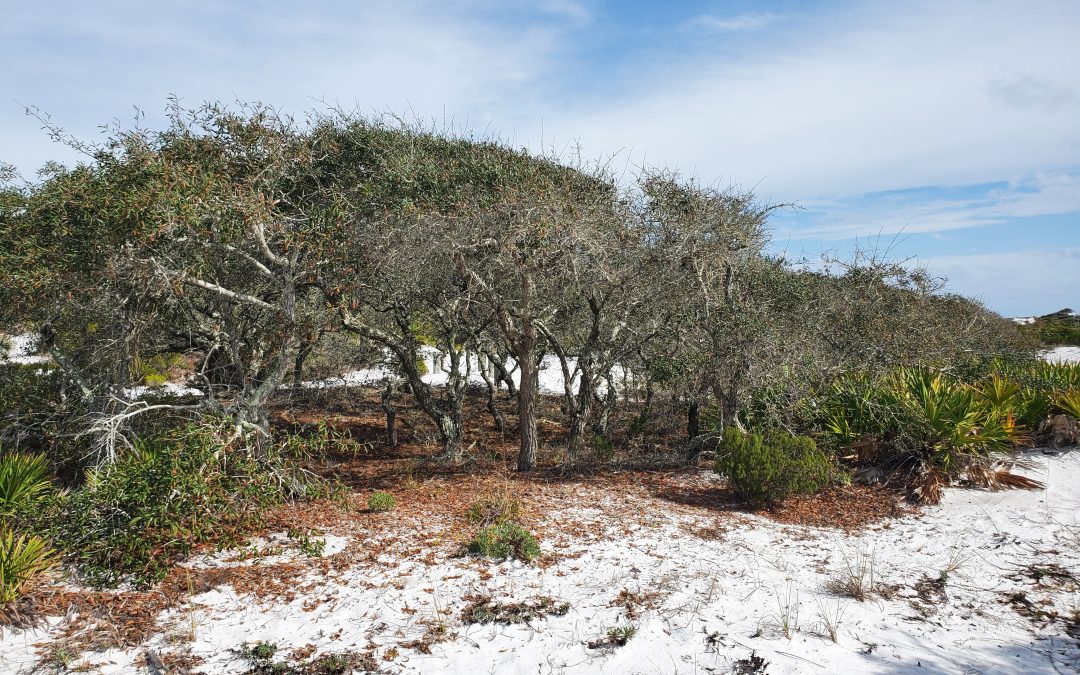
by Evan Anderson | Nov 20, 2025
Talking about a live oak might bring to mind pictures of grand, old, stately trees, limbs dripping with Spanish moss. The Southern live oak is a staple of the coastal south, but it prefers to live inland from our beaches. It leaves the salt-sprayed beach sand to its cousin, the sand live oak.
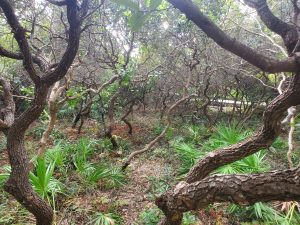
A grove of sand live oak trees.
Sand live oak can potentially grow as tall as its relative, but is rarely seen reaching such heights. Growing on beach dunes, it is constantly pruned back by the wind and sometimes remains as a low shrub. When given some relief from the elements, it will happily grow taller.
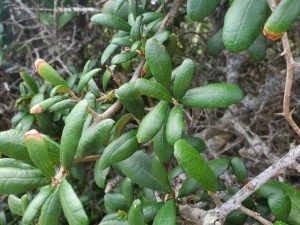
The leaves of a sand live oak.
Its scientific name, Quercus geminata, comes from latin, meaning ‘twinned‘. This refers to its acorns, which are typically borne in pairs. The tree’s leaves are tough, leathery, and relatively small, with the edges curled downward. The bottoms of the leaves are gray to whitish, often with a fuzzy texture to them. While the sand live oak stays green all year, it does drop its leaves in the spring and immediately replaces them. It often grows in clusters, sometimes due to its ability to regenerate from its roots after a fire. This can lead to groves of wavy, leaning trunks that spread out widely, each reaching for its own patch of sunlight.
Very little seems to harm a sand live oak. They are sturdy in intense wind, able to withstand extreme drought, tolerant of salt spray, and do not mind intense sun and blazing hot temperatures. They are usually pest and disease free, though overwatering can damage their roots and cause dieback in the above ground parts.
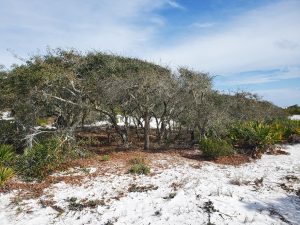
Sand live oaks pruned by salt spray and constant wind.
Potential drawbacks of this species include their copious pollen production, and their tendency to stain surfaces with their tannin-rich leaves and acorns. In all, however, they are incredibly hardy and beautiful trees when planted in their native habitat. They require little to no maintenance and offer benefits to wildlife, who will snack on their acorns. For a shade tree near the beach, make sure to put the sand live oak at the top of your list.
Evan Anderson
Walton County Horticulture Agent
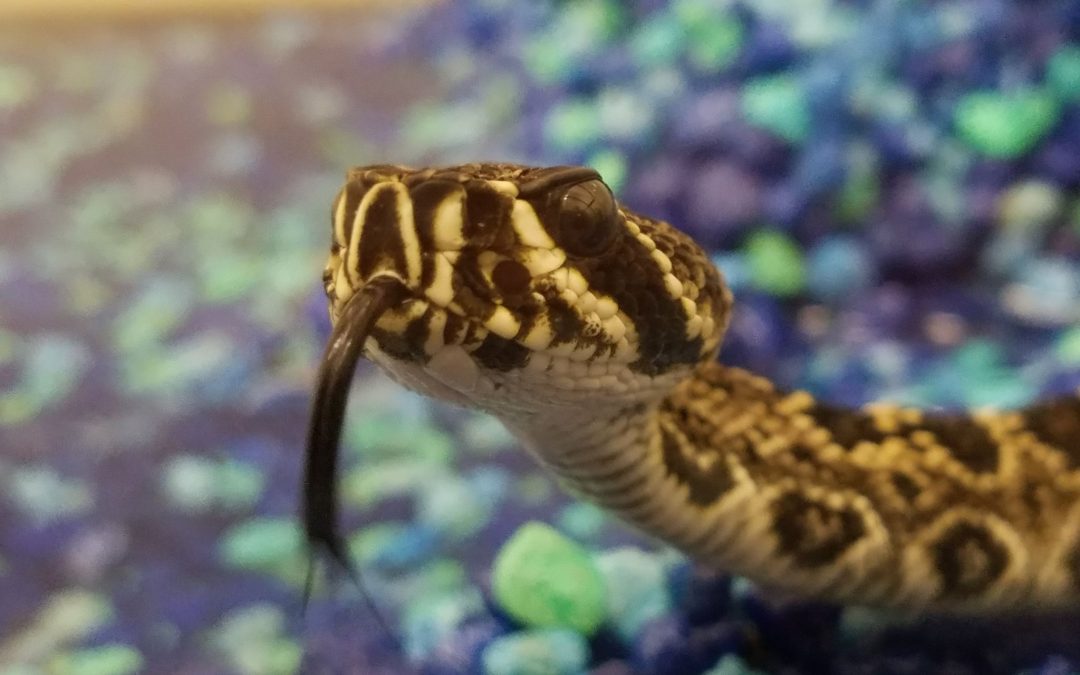
by Evan Anderson | Oct 10, 2025
Snakes of the Panhandle
Love them or hate them, snakes are a common sight in the Florida panhandle. It can be tempting to lump all snakes into the category of ‘kill it on sight!’, but that approach isn’t the best. They can be harmful or beneficial – nobody wants a snakebite, venomous or not, but snakes can play a valuable role in the ecosystem, keeping rodent populations under control.
Plenty of the snakes we have in the panhandle are harmless to humans. Only six species in the panhandle are venomous, and not all are found across the entirety of the panhandle. There are plenty of other nonvenomous snakes, some of which may resemble dangerous ones.
Some of the most common nonvenomous snakes include:
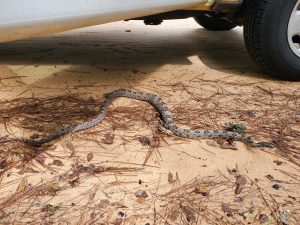 Rat snakes – Harmless, unless you’re a mouse or rat, the gray rat snake is also referred to as an oak snake. Very common and sometimes bred in captivity, especially red rat snakes.
Rat snakes – Harmless, unless you’re a mouse or rat, the gray rat snake is also referred to as an oak snake. Very common and sometimes bred in captivity, especially red rat snakes.
Black racers – One of the more commonly spotted snakes in the daytime, black racers live in urban and suburban environments. Adults are black with a white chin, feeding on rodents, lizards, frogs, birds, or even other snakes.
Ringneck snakes – Common but reclusive, the ringneck snake is small, black on top with a bright yellow underside that changes to orange near the tail. A distinct yellowish ring on its neck gives it its name. Not venomous, and does not bite.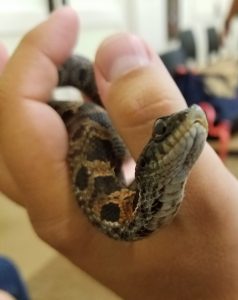
Hognose snakes – Living in dry, sandy habitats, hognose snakes are relatively small, with a distinctive upturned nose. They use this nose like a shovel, burrowing after the toads they feed on. Harmless to people, they try to appear threatening when disturbed and switch to playing dead if that doesn’t work.Garter snakes – Variable in color, but often with long stripes running the length of their bodies. Found near water, garter snakes may try to bite or release a foul smelling musk if captured. They are not venomous, however.
Water snakes – Several species of nonvenomous water snakes call the panhandle home. They live near ponds, lakes, canals, rivers, creeks, and other fresh water bodies. Most will try to bite if handled, and release foul smelling musk as a defense. They usuall feed on small fish, frogs, or sometimes small invertebrates.
King snakes – Looking very similar to the venomous coral snake, the scarlet kingsnake is not dangerous itself. It is small and likes to burrow, feeding on small lizards and rodents. It has bands of red, black, and white or yellow, but the red and white (or yellow) do not touch.
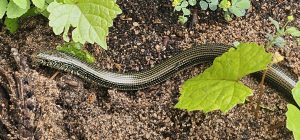 Glass lizards – Active during the daytime, these are legless lizards rather than actual snakes. Their name refers to their ability to detach their tails when in danger. The tail continues to wriggle, distracting predators while the lizard itself escapes. They eat a wide variety of insects, small creatures, eggs, and even smaller glass lizards.
Glass lizards – Active during the daytime, these are legless lizards rather than actual snakes. Their name refers to their ability to detach their tails when in danger. The tail continues to wriggle, distracting predators while the lizard itself escapes. They eat a wide variety of insects, small creatures, eggs, and even smaller glass lizards.
The varieties of venomous snakes found in the Florida panhandle are:
Pygmy rattlesnakes – Small, well camouflaged in the pine forests it inhabits, pygmy rattlesnakes are aggressive. They do have a rattle, but the sound they make is a quiet buzz more like the sound an insect might make. They normally eat frogs or other small creatures, and while a bite is unlikely to be deadly to a human, it can be painful and cause infection.
Canebreak or timber rattlesnakes – A larger rattlesnake, these can grow up to six and a half feet in length. They prefer to flee rather than fight, but can be potentially lethal if they do bite.
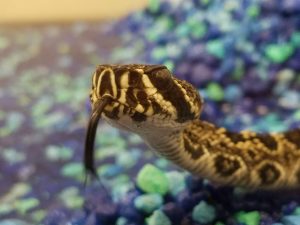 Diamondback rattlesnakes – As its name suggests, it has diamond-shaped patches along its back. Growing up to eight feet long, the diamondback rattlesnake can be dangerous and should not be approached within six feet, as it can strike quickly up to half its body length away. Thankfully, it is not particularly aggressive unless approached, and tries to warn off intruders with its rattle which produces a loud warning buzz.
Diamondback rattlesnakes – As its name suggests, it has diamond-shaped patches along its back. Growing up to eight feet long, the diamondback rattlesnake can be dangerous and should not be approached within six feet, as it can strike quickly up to half its body length away. Thankfully, it is not particularly aggressive unless approached, and tries to warn off intruders with its rattle which produces a loud warning buzz.
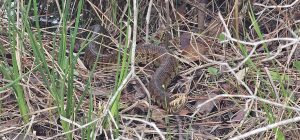 Cottonmouths or water moccasins – Found near water, the cottonmouth is named for its habit of opening its mouth, which has a whitish lining, as a threat. It may not flee when approached, and can strike aggressively. Its bite is potentially lethal.
Cottonmouths or water moccasins – Found near water, the cottonmouth is named for its habit of opening its mouth, which has a whitish lining, as a threat. It may not flee when approached, and can strike aggressively. Its bite is potentially lethal.
Copperheads – Only found in a few specific parts of the panhandle, the copperhead is marked with alternating bands of light and dark brown. Juvenile cottonmouths often resemble copperheads. The copperhead often hides beneath logs or in wood piles, and is well camouflaged amongst piles of leaves. The bite is very painful.
Coral snakes – Seldom seen, but very venomous. Coral snakes can grow to sizes of up to four feet in length, and are colored with bands of red, yellow, and black. The red bands touch yellow ones, unlike on the king snake. Coral snakes are not particularly aggressive and prefer to flee, but its venom is a potent enough neurotoxin to make caution very much advised.
Snake bites are not common, and fatalities from them are less than ten annually in the United States. Wear appropriate clothing when in wild areas, and watch where you step. Do not approach wild snakes, and do not handle freshly killed snakes. In case of a snakebite, call 911 immediately, even if symptoms are delayed. Do not risk further bites in an attempt to identify the snake – stay away! Immobilize the bitten area and keep it lower than the heart, and do not apply suction, ice, heat, or a tourniquet. Do remove tight clothing or jewelry near the bite. Note the time of the bite, what symptoms occur, and any first aid given to the victim so first responders have all the information they need.
Evan Anderson
Walton County Horticulture Agent
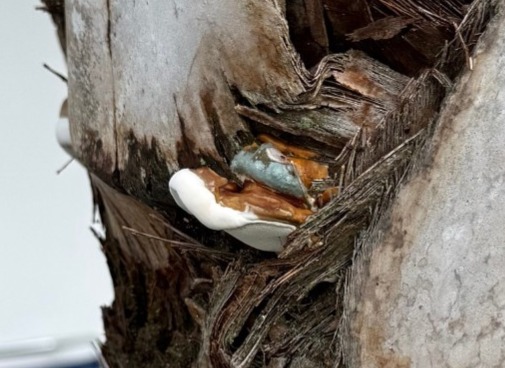
by Evan Anderson | Sep 4, 2025
No plant is as closely associated with Florida as a palm tree – the native sabal palmetto is the state tree, in fact! While this and several other species of palm are hardy even into the cooler regions of the panhandle, there are occasionally problems that arise with them. Palms tend to be sturdy in the wind, handle salt spray, and deal with drought without much issue. A few diseases can strike them, however, and the fungal pathogen Ganoderma zonatum is one of them.
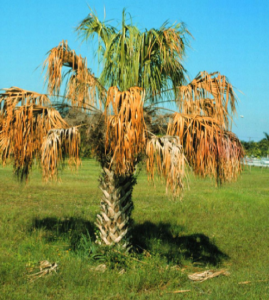
Symptoms of a tree infected with Ganoderma butt rot. Image credit: M.L. Elliott
Ganoderma butt rot, caused by this pathogen, can affect any palm tree no matter the species. It only attacks palms, so nearby hardwoods or conifers are safe from it. As a fungal disease, it spreads by spores, which are produced on a conk (a type of mushroom that is wide and flat, usually growing on decaying wood). By the time the conk is visible on the trunk of a palm, the damage is done. The fungus slowly rots away the lower four to five feet of the trunk, working invisibly until it is ready to reproduce. The trunk of the palm will not become soft or spongy as the disease develops. There may be other outward symptoms of the disease, including slower growth, off-color foliage, and wilting and dying of fronds starting from the older bottom fronds. These symptoms occur with other diseases and problems as well, making it difficult to diagnose Ganoderma butt rot until the conk is visible.
A conk will start out as a small, white, button-like growth on the trunk. As it grows, it expands, flattens out, and develops a brown or reddish-brown coating on top. Old conks turn fully brown. It is uncertain how long it takes a newly infected palm to develop conks; it may be months or even years.
Once a tree is infected with this fungus, there is no cure. Removal of the tree is the only option, and as much of the trunk, stump, and roots as possible should be taken out. Conks may form on stumps after the palm is cut down, which can help to spread the disease. The fungus, unfortunately, persists in the soil even after the palm is removed, so infected palms should be replaced with other types of plants.
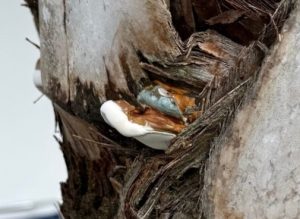
A small, relatively newly formed conk.
Frustratingly, the disease is difficult to predict. There do not seem to be any conditions that favor the disease in particular – it has been observed on otherwise healthy plants as well as stressed ones, and on naturally growing palms as well as those that have been transplanted. Still, keeping plants of any sort as healthy as possible can help them to resist pests and diseases, so fertilize, irrigate, and prune palms properly.
Evan Anderson
Walton County Horticulture Agent
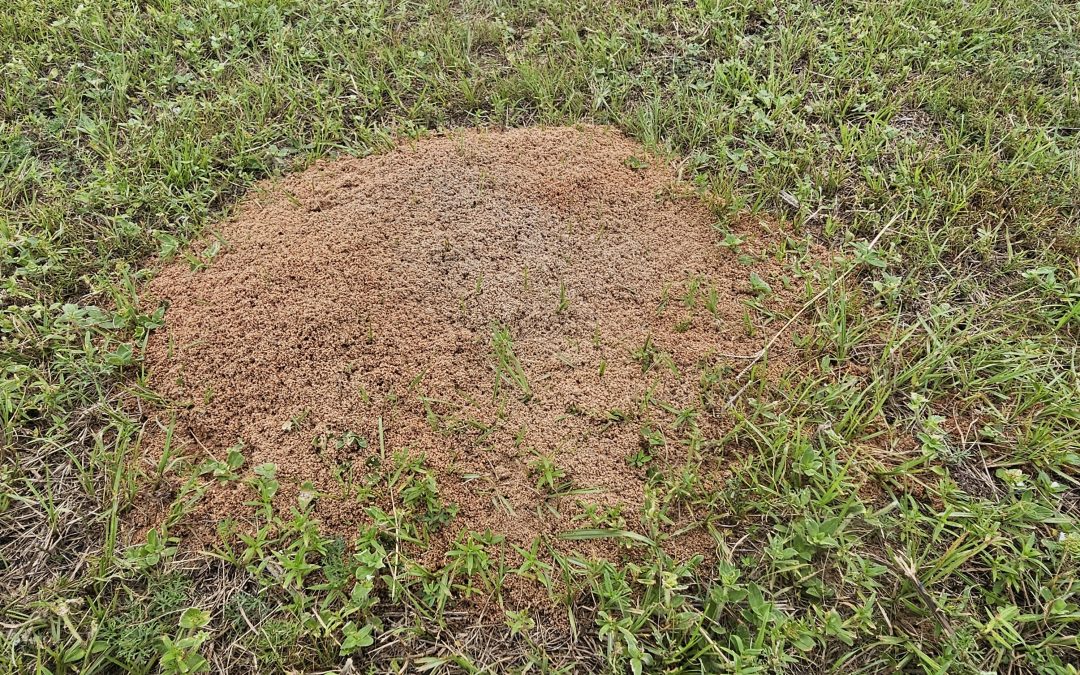
by Evan Anderson | Jul 27, 2025
The warm Florida climate makes it a biologically diverse place, with plants and animals from all over the world finding a foothold here. Some are benign, while others can become pests that harm the environment or get in the way of human activities. One such pest is the red imported fire ant, a visitor from South America. Introduced to North America somewhere in the 1930s or 1940s, these ants are native to a region of savannas and wetlands, where the rainy season brings flooding part of the year. Finding a similar climate along the Gulf coast after hitching a ride on ships, what these ants did NOT find were predators that could keep their populations in check. They have since spread throughout the southeast, and are predicted to make their way up the east coast as far as Maryland, west into Texas before it becomes too dry for them to live comfortably, and even along the Pacific coast of the United States.
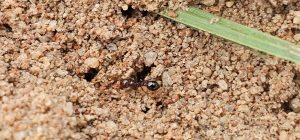
A red imported fire ant.
Though they are called ‘red’, their coloration is often reddish-brown with a darker abdomen. Populations in different areas may vary in their particular shade of color. They range in size from 1/8 to ¼ inch in length. A characteristic identifier for this species of ant is their mounds. These are not just regular anthills, where workers digging tunnels belowground dump grains of soil in a pile. Fire ant mounds help the colony regulate temperatures and moisture levels. They are often constructed in open, sunny locations. Disturbing a mound will cause the ants within it to swarm, with hundreds of ants suddenly ready to sting anything around. Their sting usually leaves a white pustule on the skin, coupled with an intense burning or itching sensation. Being attacked by fire ants is one of the least fun things you can do in a garden or landscape.
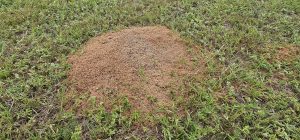
A fire ant mound.
How do we get rid of fire ants? It is important to understand that fire ants don’t live alone. They are dependent on their colony, where workers forage for food, soldiers protect the nest, and the queen (or queens – fire ant nests have been known to have multiple queens) lays eggs. The queen remains sheltered inside the nest, and until she is gone, the nest can replace its workers. Therefore, any treatment must effectively remove the queen.
Home remedies are often ineffective. Pouring boiling water over ant mounds can damage the colony, but may not reach deep enough into the mound to kill the queen. Applying dry grits to a mound will not harm the ants. Other remedies, such as club soda, simply do not work, and while gasoline and other harsh chemicals might kill some ants, they are not guaranteed to kill the queen. They are likely to cause contamination of the groundwater, however.
What are effective are insecticides, formulated as baits or mound drenches or treatments. Baits are taken by the workers back into the nest, where they are fed to the queen. Mound treatments, when properly applied, soak into the mound and are able to penetrate deeply enough to eliminate the colony. Read the label of any product you choose carefully and follow the instructions.
For more information, see our EDIS fact sheet here:
ENY226/LH059: Managing Imported Fire Ants in Urban Areas
Evan Anderson
Walton County Horticulture Agent
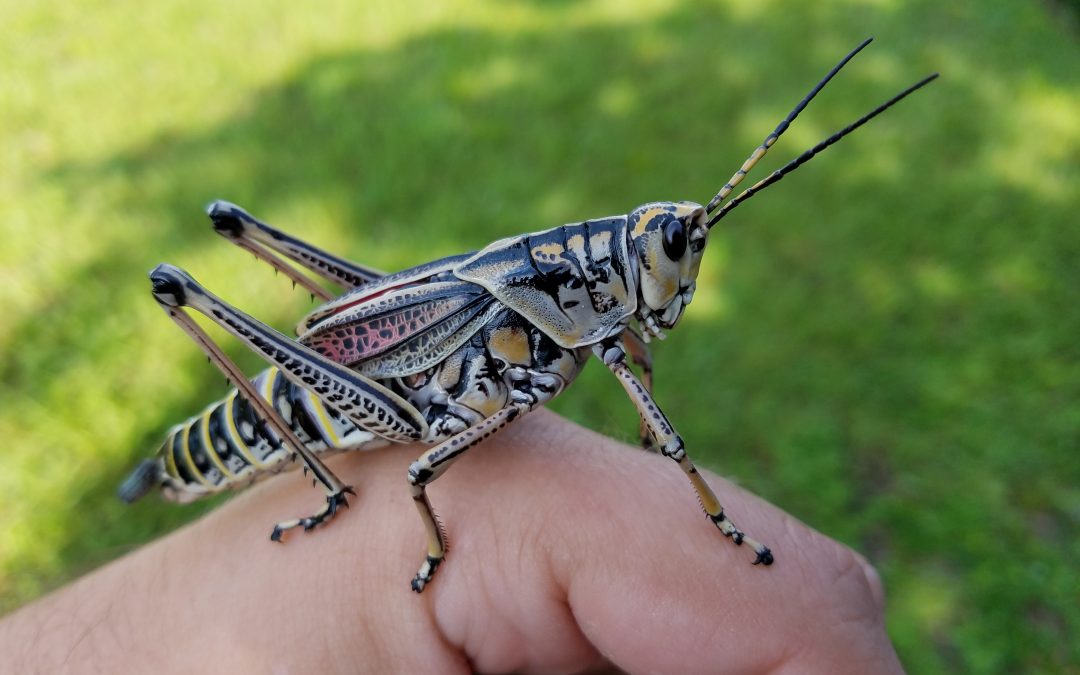
by Evan Anderson | Jun 5, 2025
The Eastern Lubber Grasshopper
From spring to early summer every year, a certain grasshopper can be seen in the Florida panhandle: the eastern lubber, also known as the Georgia thumper. Sometimes emerging in huge numbers, this can be distressing to residents who suddenly find themselves amidst what might appear to be a plague of biblical proportions. Females lay eggs in the soil, and seem to prefer woodland areas with soil that is neither too wet or too dry. With each female laying one or more ‘pods’ of eggs, and each pod containing up to 80 eggs, this can lead to a lot of grasshoppers!
Nymphs are the young and immature form of the grasshopper, and appear different than the adults. Newly hatched lubbers are black with a yellow, orange, or red stripe running down their backs. They range from about ½ inch to 1 ¾ inch long while still in the nymphal stage, and tend to stay together in groups. Adults are seen most often starting in July, growing to a size of up to 3 ½ inches in length. Adults may remain black, but are often seen in lighter colors, from yellow to orange.
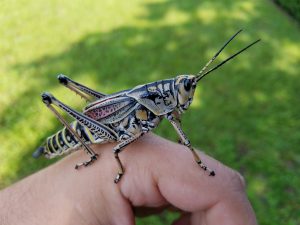
An adult eastern lubber grasshopper.
Eastern lubbers feed on a wide variety of plants. While adults prefer low, wet areas, they will sometimes damage crops or ornamental plants. They eat less than one might expect, given their size, but groups can still defoliate plants if left unchecked. Thankfully, they cannot fly, and therefore do not range over a wide area individually.
If these grasshoppers become a problem in landscapes or gardens, control methods are best undertaken early, while the insects are young. If populations are not great, they can be hand picked and removed. If treatment with insecticide is desired, there are several products available that kill lubbers. For individuals desiring a more ‘natural’ insecticide, products with the active ingredient spinosad are relatively safe to use, if slow acting. Spinosad should be applied in the early morning, late evening, or at night, to avoid affecting foraging pollinators such as bees.
Other insecticides will also work, including those with the active ingredients carbaryl, bifenthrin, cyhalothrin, permethrin, or esfenvalerate. Note that the active ingredient may not be the same as the brand name, and may only be listed in smaller print in the ‘ingredients’ portion of the product’s label. Avoid applying insecticides too close to water bodies, as they may harm fish.
For more information, see the EDIS publication on eastern lubbers at https://edis.ifas.ufl.edu/publication/IN132.
Evan Anderson
Walton County Horticulture Agent


















